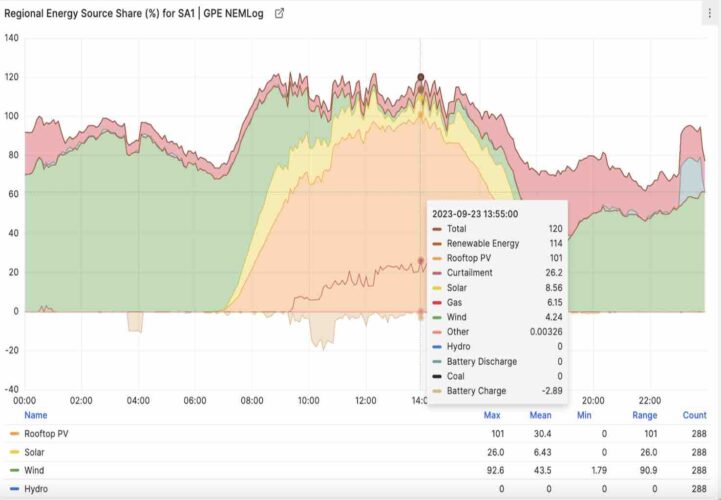The milestones continue to fall in Australia’s rapidly evolving electricity grid, with rooftop solar meeting all of South Australia’s native or underlying demand in the early afternoon on Saturday.
The milestone was noted by a number of energy analysts and date providers, including Watt Clarity and GPE NEMLog2, which provided the graph below and which said rooftop solar peaked at 101 per cent of state demand at 13.55pm on Saturday.
At the time, renewables contributed around 114 per cent of the state’s demand, exporting most of the excess while some went into storage, and a significant amount was curtailed due to negative prices. The new milestone beat the previous peak for rooftop solar of 99.2 per cent recorded a week earlier.
Such milestone are significant for a number of reasons. Firstly, because you don’t have to go too many years back to find people saying that such a milestone would be impossible without the lights going off. They didn’t.
Secondly, it underlines the fundamental shift in the way that grids are now managed. It means the end of baseload, because variable renewables such as wind and solar make the business case for such technologies largely redundant. The focus is now on renewables and “firming” and “flexible” technologies to meet demand.
South Australia is ahead of other states in Australia and the world, at least for grids of its size. The last coal generator was shut in 2016, the remaining gas plants no longer operate in “baseload” mode, and battery storage – first introduced in 2017 – is now rapidly expanding.
Rooftop solar presents interesting challenges for the market operator to maintain security of the grid, because it leaves it with few levers to control. But the introduction of synchronous condensers and the growth of battery storage, plus the ability to “orchestrate” growing amounts of rooftop solar is making it more comfortable.
For now, it keeps two gas units running at low capacity to maintain grid security, but that need will be redundant once the new link to NSW is completed in a few years time.
The main challenge then will be creating new demand in the middle of the day to soak up the still growing amounts of rooftop solar. This could come from storage, new industrial demand, shifting hot water services, and green hydrogen production.
The state is soon to announce the winning tenders of its hydrogen electrolyser and hydrogen power station in Whyalla, which could end up being a major “solar soak” in the middle of the day.
Geoff Eldridge, from GPE NEMLog, said the new milestone in South Australia is unparalleled for a large regional network both within the Australian National Electricity Market (NEM) and on a global stage.
He noted the rooftop solar had first surpassed the 50 per cent threshold in September, 2018, the 60 per cent level a year later and than 70 per cent in 2020.
“The subsequent surge was even more pronounced, with the share going beyond 80 per cent on September 26, 2021, recording 83.6 per cent, and then smashing through 90 per cent by November 21, 2021, marking 95.6 per cent per cent. From this point, however, it took almost another two years to edge from 95% to the full 100%.”
In Western Australia, which has no links to other grids and which cannot export excess capacity, the state government has commissioned a series of giant batteries contracted to the specific task of soaking up solar in the middle of the day and time shifting the output to the evening peak.
But even these contracts are only for a short period, because the state expects the growth of industrial electrification to also soak up solar in the middle of the day as green hydrogen production grows and other big industries such as refineries look to green energy to deliver zero carbon products to the international market.
As it turned out, rooftop solar reached a new record level in WA on Sunday, when it reached 1975 MW, and matched the record generation share of 74 per cent set just a week earlier. At the time, the total share of renewables in the world’s biggest stand alone grid was 83 per cent, just short of its 84 per cent record.
These rooftop solar records weren’t the only ones to fall on the weekend.
According to the Australian Energy Market Operator, the combination of blue skies and mild weather pushed operational demand in Victoria down to a new low of 2,068 MW, well below the combined output of its remaining three coal fired generators.
AEMO says this beats the previous record of 2,195 MW (by 127 MW) set last year in summer on 18 December 2022. At the time, rooftop solar contributed to 46.9 per cent of Victoria’s total electricity generation, followed by brown coal (42.8 per cent), grid-scale solar (5.4 per cent), and wind (4.9 per cent).
In NSW, battery discharge hit a record 174.5 MW at 6.30pm on Saturday and NEM wide battery discharge hit a new record of 775 MW at 6.10pm on Sunday.
Other records included instantaneous wind output in Queensland (842MW), and a record wind share (15.9 per cent).
Also in NSW, black coal output hit a record low of 2,073.0 MW at 13:55 hrs on Saturday, and coal and gas together hit a new record low of 2,073.2 MW at the same time.
Note: This story has been updated to remove reference to wind curtailment record in Queensland.












